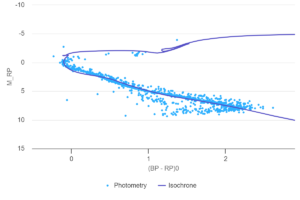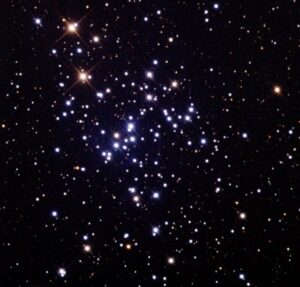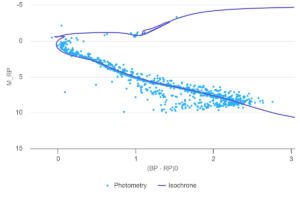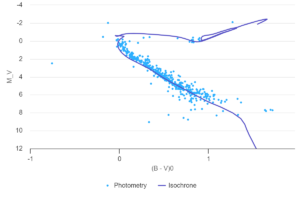Messier 93 or M93, also known as NGC 2447, is a youthful open cluster ,with its its age estimated about 100 million years, it is situated within the southern constellation Puppis. This constellation finds its origin in the grand constellation of Argo Navis, which, due to its immense expanse, was divided into three sections, Puppis being one among them. Drawing inspiration from Greek mythology, Argo Navis represents the sip embarked upon the quest for Golden Fleece, with Puppis imagined as the poop deck of this ship.
First recorded by the renowned French astronomer Charles Messier in 1781, Messier 93, initially mistaken as a comet, was duly cataloged in his renowned collection. Subsequently, this celestial gem was independently rediscovered by the esteemed British astronomer Caroline Herschel.
From Saskatoon , the M93 is not readily observable since it lies so far south that it will never rise more than 14° above the horizon.
In a 2009 study conducted by Richard Ford in South Africa, the uniform brightness of the cluster was attributed to its concentration of over 30 stars, primarily of 1st and 2nd magnitude, towards its center. From my observations, tri-color images processed in Afterglow revealed prominently bright stars at the core of the cluster, indicating a significant concentration of brightness in this region.
To conduct a comprehensive study of the open cluster and explore correlations between magnitude, brightness, color, age, and chemical composition, a dataset of 15 images was compiled. These images were captured using B, V, and R filters by the Prompt-5 telescope situated in Cerro Tololo, Chile. The exposures lasted 48.39 seconds for the B filter, 32.26 seconds for the V filter, and 16.13 seconds for the R filter. Notably, the telescope is positioned in the southern hemisphere, aligning with the observation of a cluster located within a southern constellation.
After utilizing Afterglow to stack the images from each filter and generate single combined images encompassing all three filters, a tri-image was produced. Subsequently, the tri-image was subjected to de-reddening using the E(B-V) value obtained from detailed graphs generated in Cluster Astronomer. Below is a table presenting all the values extracted from Cluster Astronomer:
| Proper Motion RA (mas/yr) | Proper Motion Dec(mas/yr) | Distance(kpc) | Log (Age(yrs)) | Metallicity
(solar) |
E(B-V) |
| -3.35 | 5.1 | 1.05 | 8.3 | 0.05 | 0.16 |




The re-reddened image from of the cluster.
Engaging in observational astronomy and conducting studies through telescopes worldwide is undeniably one of the most thrilling aspects of an astronomy class. The intriguing cluster observed here lies at a considerable distance of 1 kiloparsec (kpc). Despite its distant location, this cluster hosts approximately a thousand stars, yet it may not strike as exceptionally spectacular due to its modest radius of merely 5 light-years across. However, its richness is evident in its diverse stellar population, boasting around 54 variable stars. Noteworthy among these are a pulsating B-type star and a rotating ellipsoidal plane. Additionally, the cluster harbors four spectroscopic binary systems, one of which features a yellow straggler component. The greatest challenge encountered during this observation was accurately fitting the data into the Hertzsprung-Russell diagram, ensuring precision and reliability in the analysis.

